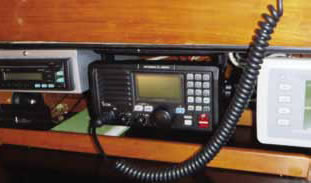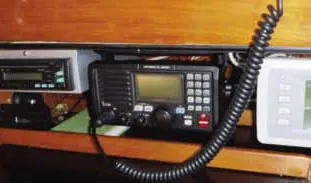
Photo by Frank Lanier
Like an increasing number of senior sailors, I require hearing aids to effectively communicate. However, in the cockpit of a sailboat-with the wind blowing or the engine running-hearing aids are not helpful when trying to carry on a VHF radio conversation. What I need is a VHF marine radio that will accept headphones (preferably noise cancelling). Of the many VHF radios that you have evaluated, have any been wired for headphones?
I have asked this question of VHF salespeople at several boat shows, and while they agreed that it makes sense to have the option on their VHFs, none said they do. I have received several suggestions on how to rewire an external speaker jack, but taking apart and modifying a new $300-$500 VHF radio just does not appeal to me. Can you help?
Gerald W. Wadley
Via email
Because headphone jacks can be a point for moisture intrusion into a VHF, some makers avoid including them. We have not tested VHFs compatibility with headphones or hearing aids in the past, so we spoke with marine VHF manufacturers to see which of their radios would be suitable for your needs. (Several seemed inspired by your query, noting that its possible that future VHFs will be Bluetooth-enabled to operate with wireless earbuds like those used with smartphones since many of the latest-generation digital hearing aids already feature Bluetooth support.)
For noise-canceling headphones, Standard Horizon, Raymarine, and Icom all recommend those made by David Clark Co. (www.davidclarkcompany.com), manufacturer of crew communications systems for the aviation and marine industries, including high-speed military boats, police boats, and offshore racing powerboats. The wireless boom-mic headsets are heavy-duty and high-quality, and their price tags reflect that; the ones we found online were priced upward of $500.
Raymarine VHFs that are compatible with the David Clark Co. headsets with integrated boom-mics are the Ray 55 (see PS, June 2012 online), Ray 218 (PS July 2012 Best Choice), and Ray 260. Icoms F5061 land-mobile VHF also can connect to a David Clark headset.
Standard Horizon: Many Standard Horizon VHFs have the capability of connecting to a speaker microphone or headset, including the HX290, HX370, HX400, and HX851. Both the HX290 and HX400 were reviewed in the July 2013 issue. The HX290, which was the Budget Buy pick, looks like an affordable option for you. The HX851, which will be included in our upcoming review of VHFs with GPS, can be used with the companys VC-24 headset microphone and VC-27 earpiece microphone.
Raymarine:Raymarine suggested its Ray 55, Ray 218, and Ray 260 radios, which not only are compatible with the David Clark headsets but can be used with remote mics that can be held to your ear as you also listen through the radios normal speaker, essentially doubling the number of speakers-not exactly what youre looking for, but it may help increase the volume. The 260 also has an optional amplified speaker available, which, according to the maker, really lets you crank up the volume while maintaining crystal-clear audio.
Icom: Like Raymarine, Icom markets submersible speaker/mics that you can hold next to your ear. Icom recommended its F3261 VHF with an HM-152T microphone or the very loud HM-184H. But the F3261 is a land-mobile VHF, so Icom would have to re-program the channels to make it marine ready, and it would be far more expensive than an off-the-shelf marine radio.
Midland: Midlands NT3VP Nautico 3 handheld VHF can use wired headphones, and it comes with a boom-mic headset, albeit a very basic one. We reviewed the NT3VP in the April 2009 issue; it was not a Recommended product.
Uniden: Manufacturer of many West Marine-branded radios, Uniden offers several headset-compatible VHFs and remote mics.
Cobra: Cobra responded that although the maker does not have a product commercially available that offers a noise-cancelling headset, they have access to such accessories and are willing to work with customers to overcome his/her hearing issue.




































